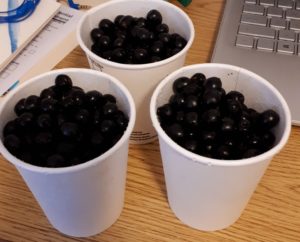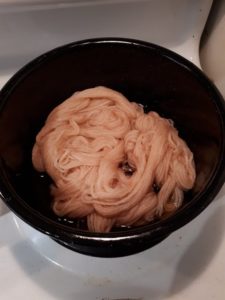Sep 19 | Gifts from our mothers, gifts from our Mother (Letters from the Coast)
All I could find were a few paper cups, so I decided they would have to do. I zipped up my raincoat and went outside into the downpour, one cup in hand and the others in my pocket, toward the laurel bushes near the church where I work.

It didn’t even occur to me to wear gloves, which was pretty silly, but I managed to pick three cups worth of the bushes’ small black berries without any ill effects. I didn’t know how I’d get them home until I found a round glass vase in my office, which I rinsed out and filled nearly to the brim. On the bus ride home, I often covered the top of the vase with my hand, irrationally worried that someone would reach out and take one and just pop it in their mouth. Of course that didn’t happen, but I didn’t want to risk it.
Later the next day, in similar weather, I did the same thing – again, very recklessly, without gloves – at a stand of yew bushes.
I feel very silly not researching more before doing these things. Both laurel and yew bushes are toxic, including branches and leaves. Nothing happened, but clearly what I still need to learn is greater respect.
I decided to pick the laurel berries first after another plant walk I did with the inimitable Lori Snyder, a Métis herbalist who has offered her knowledge of plant life, particularly indigenous West Coast plants, to various communities in my Diocese for the last few years. I like to joke that with Lori, you can walk fifty feet and it will take an hour – so knowledgeable is she about plants, and so gracious and generous our Creator in the wildly abundant giving of medicines under our feet.
Within the last five years, I’ve become more interested in gardening, probably because we now live in an apartment which has a balcony that gets a bit of sun. With my own research and my few hours with Lori, I’ve become more adept at identifying local plants and their properties.
The last time I was with her, she was standing in a bit of shade on the lawn of St. Anselm’s Anglican Church, pointing out first a blackberry bush (“Blackberries have more iron in them than any other fruit – and look how she wants us to know that she has good things for us! See how she sends out her branches saying, ‘Heeeyyy here I am! Can’t see me? I’ll go over here! Do you see me? Here I am!â€) and then a stand of laurel bushes.
“These are not native,†she said, “and they’re quite invasive. The berries are toxic, so we can’t eat them. BUT,†she added, smiling, “don’t let that stop you from finding a use for something! Berries which we can’t eat can be used for dyes!â€
I had never considered that before.
Later, heading to work, I noticed two laurel hedges bordering one of the stone walkways on the building’s front lawn. They were chock full of little black berries.
My mind whirred. What if I collected these for dye?
Why not? Even animals wouldn’t eat them. They were just sitting there.

And what a wonderful gift for the friends I have who love this church – a scarf knitted from wool dyed with laurel berries from these very bushes!
I wanted it to be a surprise, which is why I harvested on the day I did, while my boss is on study leave and I would be alone.
The yew berries were to be more of an experiment, and I quickly thought that maybe I would avoid doing this in future, as gathering and preparing them was quite a chore and could be dangerous unless a great deal of care was taken. The berries themselves – which are not really berries but a fleshy type of pine cone – are edible, but the seeds are incredibly poisonous and must be worked gently out of the flesh through crushing the berry or manipulated out with the tongue if eating. You can technically pass a seed through your system unharmed, but if it’s cracked, you’re cooked.

Why do all of this?
Some of it was just the delight of attempting a new skill.
But some of it is tied to another journey I’ve taken up, which is the journey of discovering my Gaelic roots.
My family is Scotch-Gaelic and English on both sides. Of course we’ve been Protestants for years, but go back far enough and obviously things were different. My English ancestors were zealous in their desire to unify their burgeoning empire, working to eradicate traditional languages such as Irish and Scottish Gaelic, Welsh, and Cornish, and many ancient polytheistic traditions were swept up by Mother Church. But unlike the Indigenous peoples of the Coast Salish region, whose entire cultural identity was targeted for complete erasure, many of the traditional practices of my ancestors peoples were simply forgotten or suppressed out of embarrassment.

The Gaelic tradition of keening is a case in point – once a deeply important part of the death ritual, over time it fell out of favour due to church persecution of keeners (the fact that they were almost always women surely contributed to that), but also due to it finally being seen as “primitive†and “old-fashioned†and even “too sad.†Honestly I think a lot was lost in that letting go.
I began to study Celtic Reconstructionism, often a subset of Gaelic polytheism and other reclamations of ancient Celtic religion and rites, not long after moving into the place I live in now. I was most of all interested in learning about my own people in order to fully live into a life of reconciliation. When we are only given the categories of “white†and “other†to give us a narrative, we are doomed to constantly sacrifice nuance for power. Those whose histories and stories are stolen from them have less agency to do this – but I can very easily access the memories of my ancestors and the pieces of my ethnicity that were left behind in our scramble to embrace whiteness and the power within it. By breaking down this monoculture, I can embrace something that is mine, and not only approach non-white people in a more respectful manner, but better avoid appropriation.
I also wanted to challenge the notion that Christianity is an all-or-nothing kind of faith which, like whiteness, is not coloured by culture. The history of my faith with regards to traditional polytheism and Neo-Paganism is a thorny one (pardon the pun), but in my own heart it is not so simple; there are roses within. (Ask me about the moon – this ex-Wiccan has a weird and wonderful relationship with it!)
And so I began learning about not only local plants – the things that grow in the place where I did and do my growing – but the sacred plants of my ancestors, which include yarrow, rosemary, sage, thyme…and yew.

In dyeing my own fabric, I can also reclaim an ancient practice that deserves a revisiting, particularly as I reflect on how much more accessible and cheap it is than I ever thought possible. I only need berries (all of which I got for free), vinegar (which is cheap), and water, which I am most blessed to also receive easily (I know that is not the case for so many).
What a gift our ancestors give us – if only we would all choose to receive it.